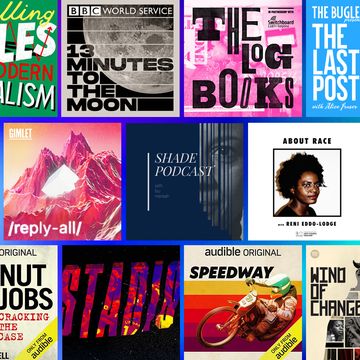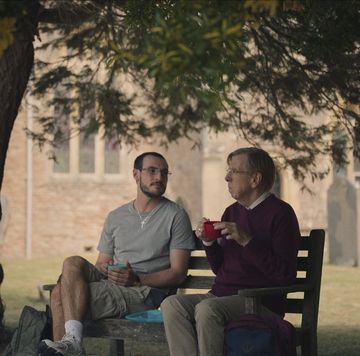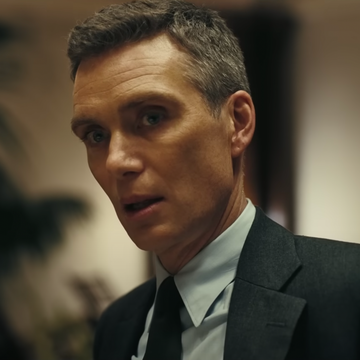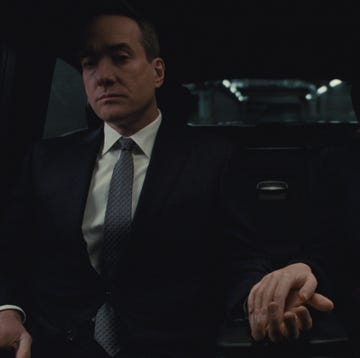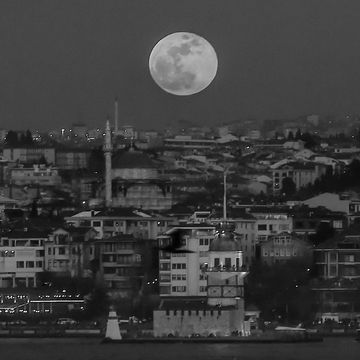Making films is hard. It's really, really hard. First you've got to write one, which takes forever, then you've got to rewrite it and rewrite it and probably rewrite it a third time. Then you've got to find someone who wants to stump up some cash for it, and find your director and your crew and your cast and your locations. And then, at the end of it, you release it, it gets a lukewarm three-star review and nobody goes to watch it.
But the standout moments in cinema this year didn't all come from Oscar-bait dramas and box office-gobbling behemoths. Films which ended up a bit lumpy, or uneven, or too long, or a bit boring, can still have a lot of magic in them. Equally, there's a moment in every huge hit which upends your expectations and makes you realise that you're watching something a bit special. Specifically, we mean that bit in A Star Is Born where Jackson Maine wets himself at the Grammys. This is our pick of the best scenes of 2018.
Crazy Rich Asians
The scene: the final song and dance
It's easy to be cynical about 'feel good' films until you're actually sat there, feeling good. Crazy Rich Asians was a box office smash not just because it represented a watershed moment in Hollywood by way of its all Asian-cast, or even because it buried so many rom-com tropes by putting a complex and competent lead woman at its core, but because it was so damn funny.
The Instagram-age Cinderella reaches its inevitable happy ending - boy proposes on plane, girl says yes, evil mother-in-law becomes slightly less evil - then launches into the best comedy music-and-dance curtain close since Shrek, bring all the excellent supporting cast back to the strains of Coldplay's 'Yellow' being covered by Katherine Ho. That huge smile on your face? Embrace it.
- Sam Parker
Adrift
The scene: The extremely massive rogue wave
The tale of Tami and Richard, two besotted young sailors lost at sea while trying to cross the Pacific Ocean, didn't exactly sink without trace this summer, but it didn't make a particularly big splash either. However, Everest director Baltasar Kormákur knows how to put together a spectacular battle with nature, and having spent the film juggling two timelines - one showing the aftermath of an almighty storm, the other the tepid romantic plod of how the couple met - the reckoning with the sea which ties them together really delivers.
The camera sits at the boat's stern as it rocks and ploughs through huge wave after huge wave. Tami and Richard cling on through a particularly massive one, and it looks like they've got some respite. Then you realise with horror that the expanse of blue ahead of them isn't the sky; it's a wall of water about 10 storeys high. It hits, and the camera follows Tami in the cabin, keeping her upright in the frame as the room flips around her. It's a sharp, brutal bit of direction, and says in 90 seconds what the 90 previous minutes had been trying to: the sea is really, really scary guys.
- Tom Nicholson
Bohemian Rhapsody
The scene: Live Aid
You can debate all you like when the last great moment in live rock music took place and indeed whether they'll ever be another one again. But if you were picking the greatest moment, you'd be fool to ignore Queen - and in particular Freddy Mercury's - performance at Live Aid 1985. It was spine-tingling stuff from the moment the opening bars of 'Bohemian Rhapsody' rang out, a true rock God at the peak of his powers playing to the entire world.
All the more impressive, then, that this year's otherwise soft-batted Mercury biopic managed to recreate the moment so perfectly, staying faithful to the memory of the concert while adding subtle directorial flourishes that suggested Freddie knew he was doing something very special. A lot of it is in Remi Malek's incredibly committed performance - one that, in a better film, would have seen him lapping up awards like no one's business.
- Sam Parker
First Man
The scene: Neil Armstrong avoids talking to his sons about going to the moon
The best scene of First Man is very small and very quiet compared to the deafening rattle and vast scope of the Saturn V launch and the moon landing sequence, but it's utterly pivotal. Janet Armstrong (Claire Foy) has finally forced husband Neil (Ryan Gosling) to explain to his sons that he is about to embark on the most dangerous and complex undertaking ever attempted by humanity. Instead of being reassuring or quietly introducing the idea that he could very well die, Armstrong approaches it like a press conference, playing a straight-bat to his older son's questioning: "There are risks, but we have every intention of coming back."
Then comes some of Foy's best-ever bits of subtle emoting, which is saying something for the queen of doing enormous amounts without appearing to do anything at all. Something breaks between Janet and Neil in that moment. If she'd thought going to the moon might irrevocably change her husband, she realises then that they're already worlds apart.
- Tom Nicholson
Climax
The scene: The opening dance
Gaspar Noé can be a bit of a self-consciously outrageous arse of a director sometimes, and there are many bits of Climax which are extremely hard to watch. It could've done with some chopping - depending on how squeamish you are, you might spend as much as two-thirds of the film wishing that it was over - but not a second of its opening dance sequence is wasted.
It's all about a dance troupe which gets snowed in at an empty school they're rehearsing at. They have a bit of a party, someone spikes the punch with LSD, and everything goes a bit Hieronymus Bosch. It opens, though, with a stunning 10-minute single-take shot of the 20 dancers rehearsing their routine to thumping techno. It's a pulsing, sensual, sweaty and thrilling piece of cinema, as the camera sweeps up and over the top of the writhing mass of contorting bodies and captures the sheer excitement of being young and alive.
- Tom Nicholson
Annihilation
The scene: The final showdown in the lighthouse
Alex Garland (Ex Machina, 28 Days Later) likes a 2001: A Space Odyssey-style interpret-it-yourself ending, and the opaque, dreamlike conclusion to sci-fi riddle Annihilation is a belter. After exploring Area X, where an extraterrestrial force called the Shimmer has started making animals and people mutate, Natalie Portman's Lena meets her alien doppelganger in the lighthouse at the centre of the Shimmer and apparently tricks it into destroying itself with a phosphorous grenade.
But who made it out of there: the real Lena, or the shape-shifting alien that took her form? Theories abounded, taking in everything from Plato's allegories to evolutionary theory to visions of ecological apocalypse. Garland still hasn't given many pointers - "I have my own interpretation or thoughts about what's going on, and if other people don't share it, or if they have their own, I'm completely cool with that" - and it's still open to dissection.
- Tom Nicholson
They Shall Not Grow Old
The scene: That moment where the colourisation kicks in
Peter Jackson's passion project turned archive footage and interviews from the First World War into visceral modern frontline reportage. The moment when jittery, monochrome, square century-old newsreel footage of men picking their way across a muddy ridge floods with colour, adds painstakingly recreated sound and goes widescreen feels miraculous however many times you see it.
Suddenly, these British soldiers aren't a stoic, faceless mass, but the cheeky, terrified, hopeful young men they were. And they were so young: it's one thing to read that some underage Tommies fibbed a bit to recruiting officers, but in They Shall Not Grow Old you can look into the sea of faces and realise with a jolt that so many of them are just boys of 16 or 17, with ideas of gallantry and empire that are about to collide head-on with mechanised slaughter. It's you, your brothers, your cousins, your mates from high school, all walking into hell.
- Tom Nicholson
Roma
The scene: The student protest riot
Between the slow sloshing of water over a driveway which Roma opens with and a final exhausting crescendo on a beach which it foreshadows, Alfonso Cuarón's family drama based on his own childhood in early 1970s Mexico could fill most of this list on its own. A set piece from the middle of the 1971 Corpus Christi Massacre, in which police and soldiers attacked student protestors, stands out though.
Cléo, a middle-class family's maid, and her employer Teresa are shopping for a crib for Cléo's imminent baby in a department store. Suddenly, there are gunshots outside. As the camera sweeps around to look out of the shop window, hundreds of rebels spill across the square outside before bursting into the shop and shattering the peace.
The unhurried, unobtrusive slow camera pans Cuarón uses throughout the film come into their own here: everything happens in one shot, and with so many moving parts within the scene to time perfectly, it's a technical marvel as well as delivering an emotional gut-punch.
- Tom Nicholson
Isle of Dogs
The scene: The poisoned sushi preparation
There are many moments in Anderson’s stop-motion masterpiece in which the minuscule details make you lean closer to get a better look. The way each dog’s hair flutters in the breeze or how cotton-wool is used to show the flurry of fights that burst into life throughout the film.
But what is easily Isle of Dogs most visually impressive and pleasing moment comes in the form of an aerial shot of sushi being assembled in order to kill a professor with poison-laced wasabi.
Only Wes Anderson could take a mechanical scene of slicing and dicing and turn it into an elaborately choreographed sequence that dances as it unfolds in front of you. This is likely because it is only Wes Anderson who would considerate reasonable to spend 7 months working on 45 second clip of Octopus writhing and some crab claws being cracked.
– Olivia Ovenden
Hereditary
The scene: The decapitation
In Hereditary, it is the sounds which give it such an unsettling edge. The steady clucking of Charlie’s tongue clicking or the snip of flesh as she cuts the head from a pigeon.
In one of the most visceral moments in Ari Aster’s film, Peter drives his sister to the hospital as she convulses from a severe allergic reaction in the backseat. While you’d be hard pressed to argue the visual horror of the scene is incidental to the effect – Charlie gets decapitated by a telephone mast - it is the ranges of noises the make this moment truly chilling.
Charlie’s crazed rasps for breath as her throat closes up, the screech of tires as Peter swerves, the fleshy thud as her head hits the pole. When the car stops there’s only silence and his short shallow breaths until the next morning when we hear his mother's animal howls of grief at the news.
– Olivia Ovenden


